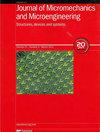From microchips to microneedles: semiconductor shear testers as a universal solution for transverse load analysis of microneedle mechanical performance
IF 2.1
4区 工程技术
Q2 ENGINEERING, ELECTRICAL & ELECTRONIC
引用次数: 0
Abstract
Microneedles are a promising technology for pain-free and efficient pharmaceutical delivery. However, their clinical translation is currently limited by the absence of standardized testing methods for critical quality attributes (CQAs), such as mechanical robustness, which are essential for demonstrating safety and efficacy during regulatory review. A key aspect of mechanical robustness is transverse load capacity, which is currently assessed using diverse, non-standardized methods, which have limited capability to measure transverse failure forces at different heights along a microneedle. This is critical for understanding mechanics of potential failure modes during insertion after skin penetration. In this work we utilize a wire bond shear tester, a piece of test equipment widely used in the semiconductor industry, to measure the transverse load capacities of various microneedle designs. This approach is compatible with diverse microneedle types, geometries, and materials, and offers high-throughput and automated testing capabilities with high precision. We measure transverse failure loads with micron-scale control over the test height and have established comprehensive profiles of mechanical robustness along the length of different microneedle designs, which is a capability not previously demonstrated in literature for polymeric and metal microneedles. Transverse failure forces were 10 ± 0.3 gf–128 ± 12 gf for wire bonded gold and silver microneedles, 11 ± 0.7 gf–480 ± 69 gf for conical and pyramidal polymeric microneedles, and 206 ± 80 gf–381 ± 1 gf for 3D printed conical stainless steel microneedles. Additionally, we present standardized definitions for microneedle structural failure modes resulting from transverse loads, which can facilitate root cause failure analysis and defect detection during design and manufacturing, and aid in risk assessment of microneedle products. This work establishes a standardized approach to evaluating a significant CQA of microneedle products, which is a critical step towards expediting their clinical adoption.从微型芯片到微针:半导体剪切测试仪作为微针机械性能横向载荷分析的通用解决方案
微针是一种前景广阔的无痛高效给药技术。然而,由于缺乏关键质量属性(CQA)(如机械坚固性)的标准化测试方法,微针的临床应用目前受到限制,而机械坚固性对于在监管审查期间证明安全性和有效性至关重要。机械稳健性的一个关键方面是横向负载能力,目前采用的是各种非标准化方法进行评估,这些方法测量沿微针不同高度的横向破坏力的能力有限。这对于了解皮肤穿透后插入过程中潜在失效模式的力学原理至关重要。在这项工作中,我们利用半导体行业广泛使用的线键剪切测试仪来测量各种微针设计的横向负载能力。这种方法与各种微针类型、几何形状和材料兼容,具有高通量、高精度的自动测试能力。我们测量了横向破坏载荷,对测试高度进行了微米级控制,并建立了不同微针设计长度上的机械稳健性综合剖面图,这是以前文献中没有展示过的聚合物和金属微针的能力。线粘合金银微针的横向破坏力为 10 ± 0.3 gf-128 ± 12 gf,锥形和金字塔形聚合物微针的横向破坏力为 11 ± 0.7 gf-480 ± 69 gf,3D 打印锥形不锈钢微针的横向破坏力为 206 ± 80 gf-381 ± 1 gf。此外,我们还提出了横向载荷导致的微针结构失效模式的标准化定义,这有助于在设计和制造过程中进行根本原因失效分析和缺陷检测,并有助于对微针产品进行风险评估。这项工作为评估微针产品的重要 CQA 建立了标准化方法,这是加快微针产品临床应用的关键一步。
本文章由计算机程序翻译,如有差异,请以英文原文为准。
求助全文
约1分钟内获得全文
求助全文
来源期刊

Journal of Micromechanics and Microengineering
工程技术-材料科学:综合
CiteScore
4.50
自引率
4.30%
发文量
136
审稿时长
2.8 months
期刊介绍:
Journal of Micromechanics and Microengineering (JMM) primarily covers experimental work, however relevant modelling papers are considered where supported by experimental data.
The journal is focussed on all aspects of:
-nano- and micro- mechanical systems
-nano- and micro- electomechanical systems
-nano- and micro- electrical and mechatronic systems
-nano- and micro- engineering
-nano- and micro- scale science
Please note that we do not publish materials papers with no obvious application or link to nano- or micro-engineering.
Below are some examples of the topics that are included within the scope of the journal:
-MEMS and NEMS:
Including sensors, optical MEMS/NEMS, RF MEMS/NEMS, etc.
-Fabrication techniques and manufacturing:
Including micromachining, etching, lithography, deposition, patterning, self-assembly, 3d printing, inkjet printing.
-Packaging and Integration technologies.
-Materials, testing, and reliability.
-Micro- and nano-fluidics:
Including optofluidics, acoustofluidics, droplets, microreactors, organ-on-a-chip.
-Lab-on-a-chip and micro- and nano-total analysis systems.
-Biomedical systems and devices:
Including bio MEMS, biosensors, assays, organ-on-a-chip, drug delivery, cells, biointerfaces.
-Energy and power:
Including power MEMS/NEMS, energy harvesters, actuators, microbatteries.
-Electronics:
Including flexible electronics, wearable electronics, interface electronics.
-Optical systems.
-Robotics.
 求助内容:
求助内容: 应助结果提醒方式:
应助结果提醒方式:


